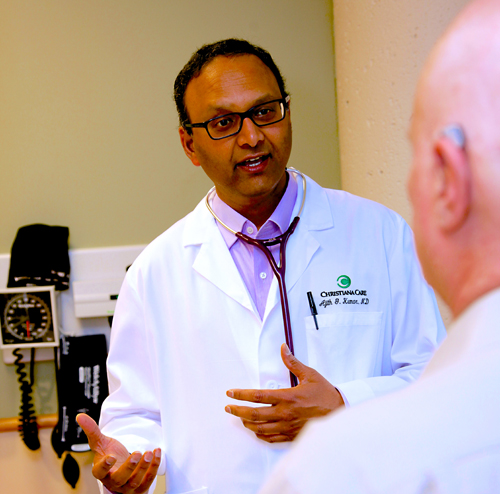Embedding a cardiologist in your primary care office brings specialty access closer to home


A program that pairs Christiana Care cardiologists with primary-care physicians in a single office is turning out to be good for patients, doctors and everyone interested in making medical care more effective and efficient.
Two years ago, Christiana Care Cardiology Consultants began an “embedded cardiology service,’’ in which a cardiologist spends one or more regularly scheduled days each week in the office of a primary-care clinician, said Penny Vigneau, senior vice president, Cardiovascular and Behavioral Health Services. The first to offer the program was the Smyrna Family Medicine office at the Smyrna Health & Wellness Center. Cardiologists are also now embedded in Christiana Care primary-care offices in New Castle and on Lancaster Pike, and will be incorporated into a new facility on Concord Pike due to open in January.
Like many good ideas, the embedded cardiologist program was born out of necessity, Vigneau said. After Cardiology Consultants became employed by Christiana Care, space became an issue. The program started out to meet a logistical need, she said, “but with the concept of a patient-focused medical home and integrated medical care, we thought it was a good model for changes coming with health care reform.’’
Phil Chapman, director of Christiana Care Cardiology Consultants’ Heart & Vascular Physician Practice Network, said cardiologists rotate weekly among participating primary-care offices.
“Having a cardiologist in the house makes it possible for primary-care physicians to tap that expertise on the spot if a patient’s test results or symptoms are unclear,” he says.
Sometimes, that can be life-saving. “We had a case where a patient was seen by a primary-care physician who sent the patient for a stress test,’’ Vigneau said. The test results raised concerns, so the patient was seen right away by the cardiologist and was sent directly to the hospital for catheterization.
Those cases don’t happen every day, said cardiologist Lawrence Narun, M.D., who works in the Smyrna practice one day a week. Far more common are the everyday interactions that build relationships among physicians and allow for more effective medical treatment of patients, he said.
“It’s very easy for the primary-care physician to come grab me, ask a question, show me an EKG, or discuss a patient I saw last week,’’ he said.
Collaboration among physicians leads to a cohesive treatment plan for patient care while reducing unnecessary testing and costs. “Communication improves patient care,’’ he said.
“That’s why we’re doing it — to help expedite the right care and get people talking to each other,’’ said Alan S. Greenglass, M.D., senior vice president and executive medical director of the Medical Group of Christiana Care. “It’s improving the value we offer our community and the individual patient, because we’re getting the right care, sooner.’’
It also “potentially reduces costs to society and the patient, because we’re not doing something unnecessary, or automatically sending a patient to the Emergency Department or for tests,’’ Dr. Greenglass said. “The concept of having medical specialists under one roof with primary-care physicians isn’t unheard-of, but it’s not common in Delaware fee-for-service business models.
“Every time we divert someone from going to an emergency room, or the cardiologist says, ‘don’t worry about that,’ we forego revenue,’’ he said. “We’re doing this as a first step, to learn, and because we think in the future there will be a financial model that will support it.’’
But the focus remains on coordinating care around the patient, rather than the providers. “We’re spending health care dollars more wisely and making sure the patient gets the treatment needed,’’ he said. “We’re doing it because we think it’s the right thing to do.’’